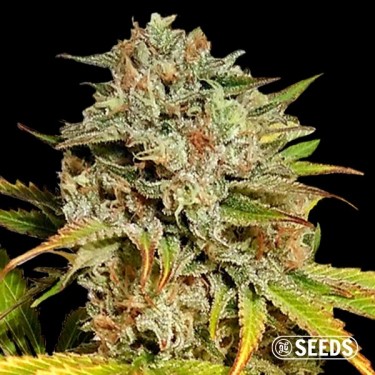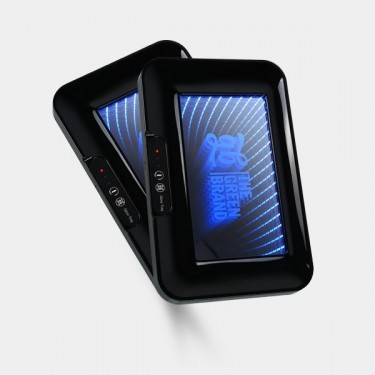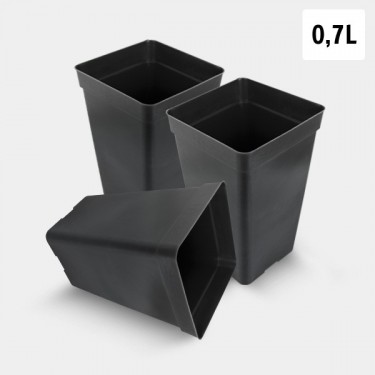Seed trays and pots
When it comes to choosing the best seed trays and pots for your plants, it is extremely important to take into account the different growing needs to determine whether your crop is fruitful or not. Thus, GB The Green Brand has the best quality and widest trays and pots for sale in order to meet every customer’s needs for their plants.
Seed trays and pots Best Sellers

Black Square Plant Pots

Black Fabric Pots

Gray Flood table

Reinforced Square Flowerpot
Regular price
- Reduced price

Square Flower Pot Tray

Legs and frames for grow tables
Regular price
- Reduced price
There are 53 products.
All the catalog: Seed trays and pots

1L Square Pot Pack
Regular price
- Reduced price
GB The Green Brand Products

GB Lighting LED Panel Pro 250 W
Regular price
- Reduced price

Auto Critical GB XXL

Grinder Aluminio GB 4 Partes 40mm

Auto Ak XXL

GB Endless Mirror Tray

GB Lighting 720W PRO MAX Dimmable LED System
- New

Plant Labels

Special White Pot for Autoflowering

Self-watering pot saucer

Square Pot Saucer - 100 X 100 Cm

Black Elevated Square Flowerpot

Special Black Pot for Autoflowering

Push-in Plant Labels

3L Square Pot Pack
Regular price
- Reduced price

0.7L Square Pot Pack
Regular price
- Reduced price

0.4L Square Pot Pack
Regular price
- Reduced price

Black 110x55x4cm Tray
Regular price
- Reduced price

Black 117x40x4cm Tray
Regular price
- Reduced price

Wheel Kit for Trays
Regular price
- Reduced price

Stepped Drill Bit
- On sale!

Wide selection of pots and growing tables
At GB The Green Brand, we provide everything growers need, no matter the growing method chosen. From plastic pots for growing a few plants at home to equipment for professional hydroponic systems, we’ve got you covered. Our product range focuses on three key areas: growing pots, support trays, and ebb and flow tables for hydroponics. No matter your budget, you’ll find what you’re looking for on this page. We offer fabric or smart pots and high-end ebb and flow tables. Stay on this page or click on one of the three icons above to explore our full catalog at the best prices in France.
Different types of pots for growing cannabis
At GB The Green Brand, we offer a wide selection of growing pots for both experts and beginners. The choice of pot depends on several factors, such as capacity, growing technique, the needs of each strain, and the stage of the plant’s life cycle. Don’t miss out on recent horticultural innovations like breathable fabric pots or the Air Pot technology.
Plastic pots
Plastic pots are undoubtedly among the best-selling options for growing cannabis. Today, there are a variety of sizes and formats available on the market. This way, every grower can find the ideal container based on the type of strain (autoflowering or photoperiod), the size of the variety, and the plant’s stage of life. We even have containers the size of a yogurt cup for germination.
Reinforced Square Pot
Versatile pots that allow you to grow mother plants, large-sized plants, or non-photoperiodic varieties. Their dimensions enable roots to grow both horizontally and vertically. Additionally, their elevated design promotes evapotranspiration of plants through the holes made for this purpose.
Air pot technology and fabric pots: smart pots for enhanced growth
Technological innovation touches all aspects of horticulture, even for accessories as simple as pots. Containers made of geotextile or Air Pot (patented technology) were designed with the same goal. Their respective designs allow roots to self-prune upon contact with air, encouraging them to naturally multiply. This process occurs when roots penetrate or weave through the walls of the pot.
V-Pot Fabric Pot
Evocrop’s V-Pots are made of geotextile using recycled materials, ensuring good aeration for both the substrate and roots. This prevents roots from wrapping around the pot’s walls, making them stronger. Additionally, the V-Pot is equipped with handles for easy transport.
Root Pruning Pot
These containers are made of high-density polyethylene from recycled materials, available in several capacities ranging from 1L to 7L. Their design prevents roots from coiling, which could negatively affect your yield.
Growing tables for hydroponic systems
Our ebb and flow tables allow for the installation of a closed-loop hydroponic system (known as an ebb and flow system). This technique has proven effective in hydroponics, producing yields that meet expectations. We also offer various accessories to optimize your use of these growing tables, such as stands and rollers as well as drain filters.
Get started with soilless growing
In hydroponics, it is crucial for roots to have optimal oxygenation and the ideal temperature to ensure productive and healthy plants. Thanks to ebb and flow tables, plants feed through capillary action, allowing growers to care for their plants without constant attention. This system has the dual advantage of oxygenating the plants and preventing them from being submerged in the nutrient solution.
EBB & FLOOD Table
EBB & FLOOD table measuring 120 x 107 x 33 cm. It fits perfectly in a 120 x 120 cm grow tent. Upon delivery, you will also receive a submersible water pump of 1000 L/h.
Trays for easier germination and repotting operations
On this page, you will find a wide range of growing trays. They serve as support for delicate stages like seed germination, rooting of cuttings, or transplanting. You can easily remove them from the grow tent and place them back once the task is done. Designed to keep your growing area clean, they’re also useful for watering your plants outdoors.
Rigid trays
We offer a variety of rigid trays where growers can safely place their pots on a perfectly stable surface. These trays are robust and durable, available in various sizes so every grower can find the tray that best fits their grow space.
Black Tray 79 x 40 cm
This tray from Garland, a leading brand in gardening in Europe, measures 79 x 40 cm. Two trays fit perfectly in a 80 x 80 cm grow tent. Additionally, they can hold three Jiffy trays or rock wool cubes, making them your best ally for cuttings.
Flexible Trays
In our catalog, we also offer flexible trays, which perform the same function as traditional models. These trays offer several advantages, especially for those lacking storage space. They can be cut or folded if your grow space requires it, and they are easy to store, providing a significant space-saving solution.
Flexi Tray
This tray, made of rubber, provides optimal flexibility. When not in use, simply roll it up for easy transport. It’s waterproof and very easy to clean. It always returns to its original shape after each use.
What’s the Purpose of Growing Trays Indoors?
Using trays as support makes cuttings, repotting, or germination much easier. With a growing tray, you can perform these tasks comfortably and precisely without messing up your grow space. If you use a grow tent, simply remove the tray for the time needed, then put it back inside when done.
 Personalized attention +34 96 206 62 98
Personalized attention +34 96 206 62 98 SHIPPING TO ALL
SHIPPING TO ALL  9/10 Rating
9/10 Rating DISCREET SHIPPING
DISCREET SHIPPING
































